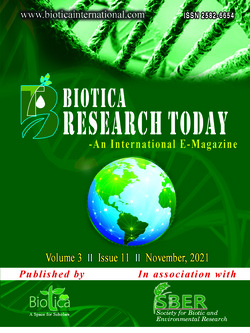
Brassinosteroid: The Potential Steroid Hormone in Crop Improvements
Anirban Bhar
Dept. of Botany (Post Graduate), Ramakrishna Mission Vivekananda Centenary College, Rahara, Kolkata, West Bengal (700 118), India
DOI: NIL
Keywords: Brassinosteroid, Crop yield, Plant stress, Steroid hormone
Abstract
Plants being sessile in nature have faced tremendous environmental resistances and biotic stress factors as compared to any other living organisms in the world. The extreme resilience of plants is actually determined by their intricate signaling cascades and intracellular metabolic cross talks. Plants do not possess any humoral immune response and rely mostly on signaling reprogramming. Internal hormonal homeostasis plays a critical role in signal transduction mechanisms and stress tolerance in plants. The physiological and developmental functions carried out by the classical plant hormone e.g., auxins, gibberellic acid, cytokinin, abscisic acid, ethylene, etc. are well documented. Brassinosteroid is the class of emerging plant hormone which is a steroid in nature and has extreme potentiality in crop improvements. Although many physiological functions of this potent plant hormone have been documented but its application in stress is still intangible. In this context, the present article envisages different aspects of this important hormone.
Downloads
not found
Reference
Kamuro, Y., Takatsuto, S., 1991. Capability for and problems of practical uses of brassinosteroids. H.G. Cutler, T. Yokota, G. Adam (Eds) Brassinosteroids: Chemistry, Bioactivity and Applications. ACS Symp Ser 474. American Chemical Society Washington, DC, pp. 292-297. https://doi.org/10.1021/bk-1991-0474.ch025.
Li, J., Chory, J., 1999. Brassinosteroid actions in plants. Journal of Experimental Botany 50, 275-282. https://doi.org/10.1093/jxb/50.332.275.
Nolan, T.M., Vukašinović, N., Liu, D., Russinova, E., Yin, Y., 2020. Brassinosteroids: multidimensional regulators of plant growth, development, and stress responses. The Plant Cell 32, 295-318. https://doi.org/10.1105/tpc.19.00335
Saini, S., Sharma, I., Pati, P.K., 2015. Versatile roles of brassinosteroid in plants in the context of its homoeostasis, signaling and crosstalks. Frontiers in Plant Science 6, 950. https://doi.org/10.3389/fpls.2015.00950.
Wei, Z., Li, J., 2020. Regulation of brassinosteroid homeostasis in higher plants. Frontiers in Plant Science 11, 1480. https://doi.org/10.3389/fpls.2020.583622.
